Cricklewood Town Square by Spacemakers
A mobile town square that packs into a miniature clock tower on the back of a bike will be appearing around north London this month (+ slideshow).
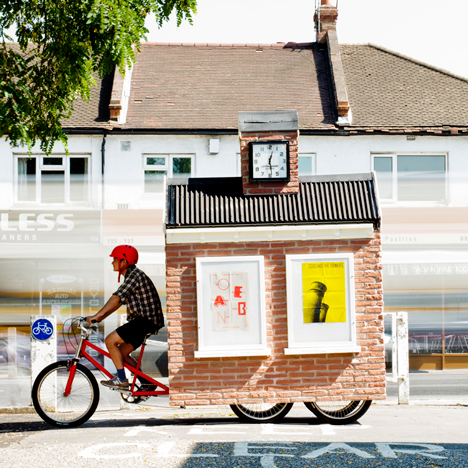
London agency Spacemakers enlisted design firms Studio Hato and Studio Kieren Jones to create the world’s first mobile town square for Cricklewood in north London. The intention of the project is to highlight the lack of green space and amenities in the community.
“Cricklewood is a community with no public space: no town hall, no library, no square, not even a single bench,” explained the designers. "The square will take the form of a civic folly on the back of a rickshaw bicycle, housing everything necessary to create a bona fide town square, including benches, stools, a clock tower, games and signage."
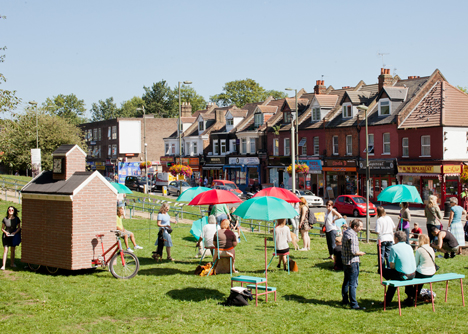
The miniature square will be installed at a number of temporary locations, including outside a DIY superstore, on a pavement near a bingo hall and a rooftop car park. It will be used to host events for the local community such as dances and film screenings.
"The project aims to show what public space can do for a community, and how even these scraps of land can be used to create a sense of place," said the designers.
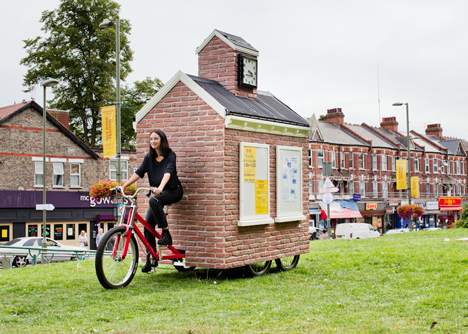
When the town square is fully installed it covers 10 metres squared. The mobile folly including the bicycle is 1.22 metres wide and 2.8 metres long. It rises to 3.2 metres in height.
It has a custom-made five-wheeled base with 12 millimetre plywood covering, faux-brick cladding and a hand-made clock. Inside, there is a collection of furniture including umbrellas, benches, tables and chairs.
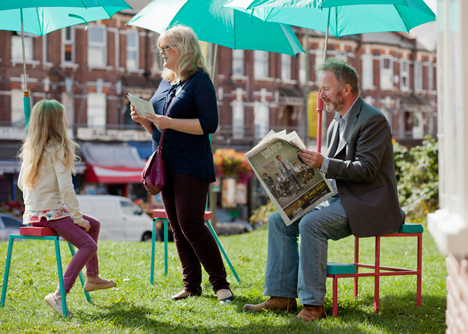
"The structure is both a practical solution - a vehicle to move the kit around - and a folly, providing a civic backdrop, helping to frame the spaces," said designer Kieren Jones. "I hope this playful solution can be the town hall that Cricklewood never had."
Cricklewood Town Square will be travelling around north London until 28 September. It will also be exhibited at the RIBA Forgotten Spaces exhibition at Somerset House in London, which runs from 4 October to 10 November 2013.
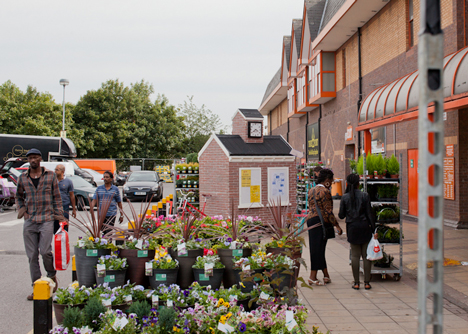
Designer Kieren Jones' other projects include the Sea Chair project that trawls the oceans for plastic waste to make furniture and a miniature factory to transform uneaten parts of a chicken into fashion items and products.
Other mobile architecture featured recently includes a tiny mobile performance stage based on sixteenth century market stalls and Roman fortune tellers and a quilted cube that is attached to the back of a tricycle.
See more mobile architecture »
Here's a project description from Spacemakers:
Spacemakers produce the world's first mobile town square
Spacemakers, the civic design agency behind the successful transformation of Brixton Village market, has enlisted Studio Hato and Studio Kieren Jones to create the world's first mobile town square. Constructed from a clever kit of parts, the innovative town square will travel by bike and move across north London from 31 August to 28 September, inhabiting patches of disused land and turning them into vibrant public spaces for all.
Cricklewood, north west London, has an intriguing history but little civic amenities left to show for its heritage - not only is there no town hall or library, there's not even a single public bench. Now the team that created the cult Brixton Village renaissance are turning their attentions north, seeking to highlight the dire lack of public space in Cricklewood via their ingenious mobile town square.
Designed and built by Studio Kieren Jones, the mobile town square will emerge in a series of forgotten spaces: from an unloved patch of grass next to B&Q, to an empty pavement outside a bingo hall, and even a rooftop car park. The square will take the form of a civic folly on the back of a rickshaw bicycle, housing everything necessary to create a bona fide town square, including benches, stools, a clocktower, games and signage.
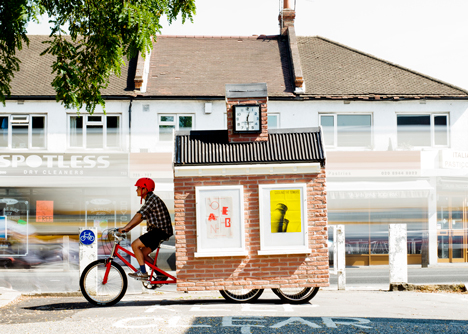
To bring the Capital's newest public space to life Londoners are invited to join in, with a dynamic programme of events running throughout the installation, from dog shows and chess championships, to tea dances and debates. Many of the events play on Cricklewood's little known past, with film screenings on a car park roof referencing the area's long lost film studios, and a DIY library where locals can read books by the town's famous literary progeny.
Designer Kieren Jones explains: “In response to the relative lack of civic space in Cricklewood, I have created a miniature and mobile town hall, which will enable the activation of places and spaces within the town centre that have been previously underused. The structure will also house a set of bespoke furniture, using local suppliers, that can be flexibly deployed. The clock tower is a reference to the Smiths clock factory that used to exist in Cricklewood, and to the decorative clock that used to exist on Anson Road, but which was sold for scrap during the war.

The structure is both a practical solution - a vehicle to move the kit around - and a folly, providing a civic backdrop, helping to frame the spaces. Cricklewood has a thriving community, but no space for this community to exist. In a way, I hope this playful solution can be the town hall that Cricklewood never had.”
The fully installed space will be up to 10 metres squared, the mobile folly including the bicycle is 1.22m wide x 2.8m long x 3.2m tall and made from a bespoke, dip-coated 5-wheeled bike base, a steel frame, with 12mm plywood covering, faux-brick cladding (polyurethane, resin and brick dust) and a hand-made clock. The square's furniture is made from a welded steel base, dip-coated in Cricklewood by local car-resprayers and finished with locally sourced, reclaimed wood.
Studio Hato were tasked with creating the signage and graphics for the square. Their solution was to come up with a DIY sign-making workshop, where local people could use stencils to create their own signs, and set their own rules, for the space.
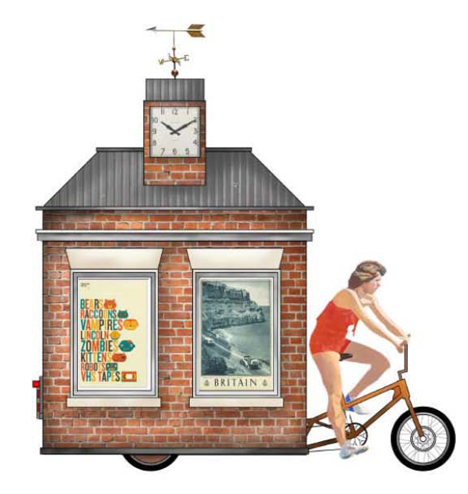
A unique font, based on the standard British 'transport' font used on street signs across the country, has been created, and will be applied using stencils to pre-cut, temporary boards, with marker pens in official signage colours: blue, red, green and brown. Wayfinding signs will also be created, pointing towards the square, and re-positioned each time the square moves.
For Spacemakers it's the incidental activities which take place on the structure which will be the most fascinating element of all, as project director Tom James reveals: "It's these unplanned elements that will really generate the social life of these squares, attracting passers by. Our project is all about giving local people permission to sit, rest, play and meet in these spaces. This free, public space, open to everyone, is vital to making any place feel like a real community."
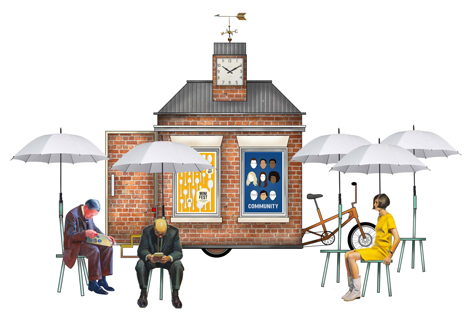
James notes that the project aims to show people what's possible, even in these scraps of land, but more than this, it aims to start a conversation. "We hope to use this project to get an idea into Cricklewood, to set a precedent that local people can use to help them work towards a permanent public space. The structure will stay in the community long-term: but just as important is the inspiration."
Cricklewood Town Square is funded by the Mayor's Outer London Fund, as part of a set of interventions in Cricklewood, led by Gort Scott Architects.
Cricklewood Town Square director Tom James is a writer and urbanist. His previous projects include GO, a cult fanzine about Sheffield which was named as one of Britain's Top Ten Arts Secrets by the Observer, featured at the Venice Biennale for architecture in 2006, and is part of the V&A's Permanent Art Collection; and Sheffield Publicity Department, an imaginary tourist board for Sheffield.
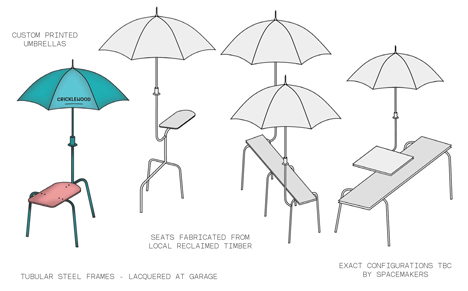
Kieren Jones is a designer and maker. His award winning work includes the Sea Chair project, a method of harnessing waste plastic in the oceans to make furniture, and the Blue Fence project: a proposal to reuse olympic fencing to create social furniture. In 2006, his 'Flatpack Rearranged' project, repurposing Ikea furniture, gave rise to the 'Ikea Hacking' subculture. Kieren leads the Materials Futures MA course at Central Saint Martins, University of the Arts London.